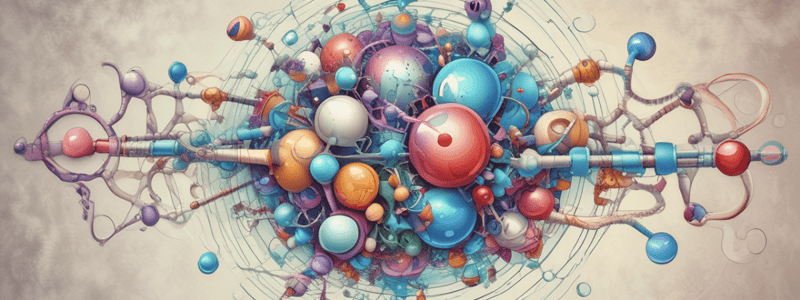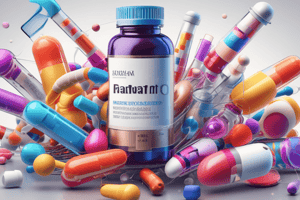Podcast
Questions and Answers
What is the relationship between agonist concentration and receptor occupancy?
What is the relationship between agonist concentration and receptor occupancy?
- The relationship is inverse, but only at high concentrations
- Increased agonist concentration increases receptor occupancy (correct)
- Increased agonist concentration decreases receptor occupancy
- There is no correlation between agonist concentration and receptor occupancy
Surmountable and insurmountable receptor antagonism are the same.
Surmountable and insurmountable receptor antagonism are the same.
False (B)
What is pharmacology?
What is pharmacology?
Pharmacology is the study of how drugs act.
A receptor is a ______________________ molecule that binds to a specific drug or ligand.
A receptor is a ______________________ molecule that binds to a specific drug or ligand.
Match the following terms with their definitions:
Match the following terms with their definitions:
What is the relationship between agonist concentration and response?
What is the relationship between agonist concentration and response?
What is the primary function of receptors in cells?
What is the primary function of receptors in cells?
Receptors are found only on the surface of cardiac cells.
Receptors are found only on the surface of cardiac cells.
What is the name of the receptor that responds to noradrenaline?
What is the name of the receptor that responds to noradrenaline?
Different cell types have different ______________ of receptor profiles.
Different cell types have different ______________ of receptor profiles.
Match the following receptors with their corresponding chemical agents:
Match the following receptors with their corresponding chemical agents:
What is the role of transporters or carrier molecules in cells?
What is the role of transporters or carrier molecules in cells?
What is pharmacokinetics concerned with?
What is pharmacokinetics concerned with?
Paul Ehrlich was awarded the Nobel Prize in 1954.
Paul Ehrlich was awarded the Nobel Prize in 1954.
What is the fundamental concept in drug action indicated by Paul Ehrlich?
What is the fundamental concept in drug action indicated by Paul Ehrlich?
Drugs can exert their effects by binding to _________ targets.
Drugs can exert their effects by binding to _________ targets.
Match the following terms with their descriptions:
Match the following terms with their descriptions:
What is the function of agonists in the body?
What is the function of agonists in the body?
Receptors show absolute ligand selectivity.
Receptors show absolute ligand selectivity.
What is the term for the ability of a drug to bind to specific receptors in the body?
What is the term for the ability of a drug to bind to specific receptors in the body?
Drugs that bind to and activate receptors are called ______________________.
Drugs that bind to and activate receptors are called ______________________.
Match the following drugs with their primary effects:
Match the following drugs with their primary effects:
What is the result of increasing the dose of a drug that acts on multiple receptors?
What is the result of increasing the dose of a drug that acts on multiple receptors?
Agonist binding to receptors is usually irreversible.
Agonist binding to receptors is usually irreversible.
What is the term for the strength of attraction between an agonist and a receptor?
What is the term for the strength of attraction between an agonist and a receptor?
The binding of an agonist to a receptor requires intermolecular forces such as ______________________ and hydrogen bonding.
The binding of an agonist to a receptor requires intermolecular forces such as ______________________ and hydrogen bonding.
What are the 4 major types or superfamilies of receptors?
What are the 4 major types or superfamilies of receptors?
Where are ion channel receptors located?
Where are ion channel receptors located?
Enzyme-linked receptors respond to fast neurotransmitters.
Enzyme-linked receptors respond to fast neurotransmitters.
Ions __ cross the cell membrane when the ion channel is closed.
Ions __ cross the cell membrane when the ion channel is closed.
Match the receptor superfamilies with their respective effector proteins:
Match the receptor superfamilies with their respective effector proteins:
Flashcards are hidden until you start studying
Study Notes
Pharmacodynamics: Molecular Mechanisms of Drug Action
- Pharmacodynamics is the study of the effects of drugs on the function of living systems.
- It involves the interaction between a drug and components of the organism.
Drug Action
- Most drugs exert their effects by binding to protein targets such as receptors, ion channels, enzymes, and transporters.
- A drug must bind to a target to produce an effect.
Receptors
- Receptors are proteins that allow a chemical agent (drugs, hormones, neurotransmitters) to initiate a change in cell function.
- Receptors are the cell's 'sensing elements' and provide molecular communication between the chemical agent and the transduction process.
- Different cell types have different receptor profiles, which determines the hormones and neurotransmitters to which the cell responds.
Agonists and Antagonists
- Agonists mimic the actions of endogenous ligands and bind to the receptor to produce a response.
- Antagonists block the actions of endogenous ligands and bind to the receptor to prevent a response.
Ligand Selectivity
- Receptors show ligand selectivity, meaning each receptor type is activated by a small number of substances.
- Receptor activation requires a good 3-D "fit" between the agonist and receptor.
Selectivity of Drugs
- Useful drugs show selectivity, binding only to certain receptors to produce a specific response.
- Selectivity is reciprocal, meaning each drug only binds to certain receptors and each receptor recognises only certain drugs.
Limitations of Selectivity
- Selectivity is not absolute, as most drugs act on more than one receptor.
- Increasing the dose of a drug can activate other receptors, leading to adverse effects.
Drug-Induced Responses
- Drugs act by binding to specific drug targets, such as receptors, to produce a response.
- Agonist binding requires intermolecular forces between the agonist and receptor and is usually reversible.
- The strength of agonist binding is determined by the forward and backward rate constants.
Receptors and Other Drug Targets
- A drug will not work unless it is bound to a protein target, such as receptors, ion channels, enzymes, or transporters.
- Receptors are sub-divided into 4 major types or superfamilies: ion channel receptors, G protein-coupled receptors, enzyme-linked receptors, and nuclear receptors.
Ion Channel Receptors
- Located in the cell membrane
- Collection of proteins form a central pore/channel
- Ions cannot cross the cell membrane without binding of an agonist
- Examples: nicotinic acetylcholine receptor
- Characteristics:
- Mechanism of signal transduction: binding of an agonist alters ion channel structure, allowing ions to flow into the cell
- Receptor location: cell membrane
- Effector protein: channel
- Time scale of action: milliseconds, very fast
- Agonist: ACh (acetylcholine)
- Antagonist: pancuronium (used to produce paralysis during anaesthesia)
G Protein-Coupled Receptors
- Also located in the cell membrane
- 7 transmembrane domains
- Examples: adrenoceptors, muscarinic acetylcholine receptors
- Characteristics:
- Mechanism of signal transduction: binding of an agonist activates a G protein, which in turn activates an effector protein
- Receptor location: cell membrane
- Effector protein: enzyme or channel
- Time scale of action: seconds, fast
- Agonist: salbutamol (relieves bronchospasm in asthma)
- G proteins link GPCRs to effector proteins that generate intracellular second messengers
Enzyme-Linked Receptors
- Also located in the cell membrane
- Examples: insulin receptor, receptors for cytokines, growth factors
- Characteristics:
- Mechanism of signal transduction: binding of an agonist activates a linked enzyme
- Receptor location: cell membrane
- Effector protein: enzyme (e.g. kinase)
- Time scale of action: minutes, slow
- Agonist: insulin (used to reduce blood glucose levels)
Nuclear Receptors
- Located in the intracellular compartment
- Examples: glucocorticoid receptor, other steroid hormone receptors
- Characteristics:
- Mechanism of signal transduction: binding of an agonist activates gene transcription
- Receptor location: intracellular
- Effector protein: gene transcription
- Time scale of action: hours, very slow
- Agonist: glucocorticoid (prednisolone, an anti-inflammatory agent)
Protein Targets for Drug Action
- Receptors: agonists bind to and activate receptors, while antagonists bind to but do not activate receptors
- Ion channels: blockers physically plug the ion channel, while modulators bind to accessory sites and modulate channel activity
- Enzymes: substrate analogues competitively inhibit the enzyme, while some drugs act as false substrates for enzymes
- Transporters: specific carrier proteins transport ions and small organic molecules across cell membranes, and some drugs inhibit transporters or act as false substrates.
Studying That Suits You
Use AI to generate personalized quizzes and flashcards to suit your learning preferences.




